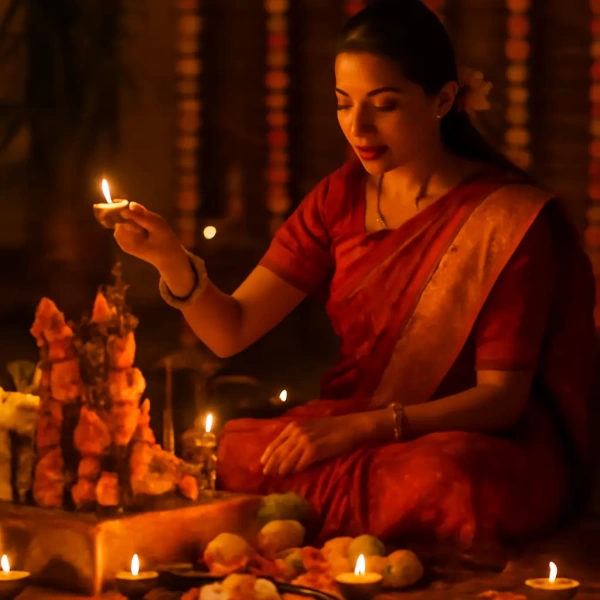Puja Vidhi & Shiv Ji Importance
Pradosh Vrat stands as one of the most revered fasting days in Hindu tradition, dedicated to the worship of Lord Shiva and Goddess Parvati. In October 2025, this sacred observance marks a spiritually potent time for devotees to seek divine protection, health, and liberation from all negativities. This blog elaborates on everything related to Pradosh Vrat October 2025, including moonrise timings, detailed puja vidhi, the significance of Lord Shiva, and its links to Sankashti Chaturthi and the grand festival of Dussehra.
Also read- Festival in October 2025: Complete List of Hindu Festivals
Pradosh Vrat October 2025 Date & Moonrise Timing
- Date: Sunday, 5 October 2025
- Day: Trayodashi Tithi (13th lunar day) of Ashwin month
- Moonrise Time: Approximately 4:30 PM (timing varies by location, check local panchang)
- Pradosh Kaal (Auspicious time window): About 1.5 hours before and after sunset, traditionally between 5:30 PM to 7:00 PM IST
- Devotees observe the vrat by fasting through the day and perform special evening puja during Pradosh Kaal.
Spiritual Importance of Pradosh Vrat and Lord Shiva
- The vrat honors Lord Shiva as the destroyer of evil and granter of boons.
- Pradosh Vrat grants protection from negative influences, diseases, and difficulties.
- It is believed that worshipping Shiva on this day removes past sins and purifies the soul.
- Fast and rituals foster spiritual discipline and bring devotees closer to Shiva’s divine consciousness.
- October’s Pradosh Vrat aligns with Ashwin month’s auspicious cycle, enriching its spiritual power.
- Devotees seek Shiva’s blessings for prosperity, health, and spiritual enlightenment.
Pradosh Puja Vidhi: Step-by-Step Guide
Preparations:
- Clean the home and puja area thoroughly.
- Wake early, take a bath, wear clean clothes, preferably white or light colors symbolizing purity.
- Set up the shrine with Lord Shiva’s idol or picture decorated with flowers, bilva leaves, and sandalwood paste.
Fasting Rules:
- Observe a strict fast throughout the day, preferably nirjala (water-only fasting).
- Some devotees consume fruits, milk, or light sattvic food prior to evening puja.
Evening Puja:
- Begin puja at Pradosh Kaal (around sunset).
- Light lamps, incense sticks, and offer bilva leaves, flowers, fruits, and water to Lord Shiva’s idol.
- Chant popular Shiva mantras such as “Om Namah Shivaya” repeatedly.
- Recite excerpts from Shiva Purana or Rudram.
- Meditate on Lord Shiva’s form as Nataraja (Lord of Dance) or as the compassionate Mahadeva.
Special Rituals:
- Perform Abhishek (ritual bathing) of Shiva Lingam with water, milk, honey, and curd.
- Offer bel leaves, sesame seeds, and sweets like bael fruit or ladoos.
- Conclude with aarti with devotees chanting or singing bhajans.
Connection to Sankashti Chaturthi and Dussehra
- Sankashti Chaturthi also falls in the Krishna Paksha (waning moon) of Ashwin, emphasizing purification and removal of obstacles through Lord Ganesha’s grace.
- Observing both fasts in close proximity strengthens spiritual momentum and balances cosmic energies of Shiva and Ganesha.
- Dussehra, the victory of good over evil, precedes this timeline, marking the destruction of negativity.
- Pradosh Vrat’s focus on Shiva complements Dussehra’s symbolism by invoking Shakti and Shiva for ongoing protection and renewal.
- Devotees benefit from these linked observances by accelerated spiritual cleansing and blessings.
Regional Celebrations and Customs
- Temples decorated with lights, especially the famous Kashi Vishwanath and Amarnath shrines, attract thousands on Pradosh Vrat.
- Devotees participate in group chants and Rudrabhishek ceremonies.
- Special community dinners (langars) and free food distribution emphasize charity and service.
- South Indian temples often organize elaborate poojas culminating in midnight celebrations.
- In Maharashtra and northern India, devotees congregate for bhajans and spiritual discourses on Shiva Purana stories.
Spiritual Benefits and Devotee Experiences
- Enhances mental focus and inner peace.
- Alleviates health issues and energizes body and soul.
- Stronger connection with Lord Shiva’s divine energy fosters fearlessness and creativity.
- Compassion and humility increase through devotion.
- Devotees report life transformation after sincere observance with faith and discipline.
Tips for Observing Pradosh Vrat Properly
- Prepare fresh puja items before sunset.
- Avoid eating grains, onions, garlic, and meat on fasting day.
- Stay calm and engage in prayers or meditation when breaking the fast.
- Use the day for reflection, self-analysis, and positive resolutions.
- Respect the timing of Pradosh Kaal for puja and moonrise worship.
Puja Vidhi & Shiv Ji Importance
Pradosh Vrat remains one of the most powerful spiritual observances dedicated to Lord Shiva and Goddess Parvati, celebrated with great devotion across India. Falling on the Trayodashi Tithi (thirteenth lunar day) of the Hindu calendar, this vrat holds immense significance by providing devotees with blessings of health, prosperity, protection, and spiritual growth. October 2025’s Pradosh Vrat falls on Sunday, 5th October 2025, and this blog provides a comprehensive guide about the Pradosh Vrat October 2025 — including exact moonrise times, detailed puja and fasting vidhi, Shiv Ji’s importance, and links to Sankashti Chaturthi and Dussehra rituals.
Pradosh Vrat October 2025: Date, Moonrise, and Puja Timing
- Date: Sunday, 5 October 2025
- Tithi: Trayodashi (13th lunar day) of Krishna Paksha, Ashwin month
- Moonrise Time (Delhi): Approx. 4:30 PM (exact time varies by location; check local panchang)
- Pradosh Kaal (Auspicious Puja Time): Around 1.5 hours before and after sunset (approx. 5:30 PM to 7:00 PM IST)
- Devotees observe fasting from early morning and perform special puja during Pradosh Kaal.
Importance of Pradosh Vrat and Lord Shiva’s Divine Grace
Pradosh Vrat centers on worshipping Lord Shiva, the destroyer of evil and granter of boons, along with Goddess Parvati. This sacred day is said to invoke Shiva’s blessings for:
- Removal of sins and negative influences accumulated over lifetimes.
- Protection from diseases, enemies, and misfortunes.
- Spiritual purification, mental peace, and liberation (moksha).
- Fulfillment of desires, prosperity, and strength for devotees.
- Removal of defects caused by malefic planetary positions (especially Saturn, Rahu, and Ketu).
- Support for those facing legal troubles, career hurdles, or family issues.
This vrat exemplifies the ideal balance of devotion (bhakti) and austerity (tapasya), paving the path for a life blessed by Shiva’s energy and compassion.
Pradosh Vrat Puja Vidhi: Step-by-Step Guide
Morning Preparations
- Purification Bath: Devotees wake before sunrise, take a clean bath, preferably with water infused with neem leaves or tulsi to purify body and mind.
- Dress: Wear fresh, clean clothes—white or light colors symbolize purity.
- Puja Setup: Clean the altar and decorate with rangoli. Place an idol or image of Lord Shiva (preferably Shiva Lingam) accompanied by Goddess Parvati and Lord Ganesha.
- Prepare Puja Items: Gather bilva leaves (most sacred to Shiva), flowers, sandalwood paste, milk, honey, ghee, curd, water, Akshat (unbroken rice), and incense sticks.
Fasting Guidelines
- Observing a nirjala fast (no food or water) is ideal for maximum spiritual benefit.
- Alternatively, devotees may consume fruits, milk, or light sattvic food until evening puja.
- Avoid grains, salt, onion, garlic, and non-vegetarian food on fasting day.
Evening Puja During Pradosh Kaal
- Purify the Puja Area: Sprinkle Gangajal (holy water) and light oil or ghee lamps.
- Abhishek (Ritual Bathing of Shiva Lingam): Offer water, milk, honey, curd, sugar, and ghee while chanting “Om Namah Shivaya” or the Maha Mrityunjaya Mantra.
- Offerings: Present bilva leaves, fresh flowers, fruits, and Datura plants to Lord Shiva.
- Chanting and Recitation: Recite Shiva Purana stories, Pradosh Vrat Katha, Shiv Chalisa, and perform aarti.
- Meditation: Meditate on Lord Shiva’s form as the compassionate Mahadeva and supreme yogi.
- Donate and Distribute: Feed Brahmins and donate food or essentials to the needy as dakshina (spiritual offering).
Concluding the Vrat
- Devotees break their fast after the puja and aarti, consuming sattvic food.
- Apply sacred ash (Vibhuti) received during puja on forehead.
- Visit Shiva temples if possible for darshan and blessings.
- Some observe night-long vigil (jagaran) for added spiritual merit.
Significance of Pradosh Vrat Stories and Legends
Legend states that on a Pradosh evening, Lord Shiva defeated the demon Tripurasura, symbolizing the destruction of evil and darkness within. Pradosh Vrat thus commemorates this victorious moment, and devotees believe that sincere worship on this day grants victory over their own inner demons—sins, obstacles, and attachments.
The Skanda Purana also recounts how Brahma and Vishnu worshipped Shiva during Pradosh Kaal and obtained his blessings. This vrat’s efficacy in removing negative karmas and disease is well documented in ancient scriptures.
Pradosh Vrat and Its Connection to Sankashti Chaturthi & Dussehra
- Sankashti Chaturthi occurs during Krishna Paksha as well, focusing on Lord Ganesha’s blessings to remove obstacles. Observing both vrat intensifies the spiritual purification during Ashwin month.
- Dussehra, celebrated before the Pradosh Vrat date, signifies good’s triumph over evil, complementing Pradosh’s focus on Shiva—the divine destroyer facilitating cosmic balance.
- Together, these festivals form a layered spiritual ritual sequence saturating devotees with divine protection and renewal.
Regional Customs and Community Practices
- Shiva temples, especially Kashi Vishwanath (Varanasi), Amarnath, Kedarnath, and Ramanathaswamy (Rameshwaram), attract large crowds for Pradosh puja.
- Devotees form groups for shared chanting, Rudrabhishek ceremonies, and bhajan sessions.
- Many regions observe Pradosh with community feasts that foster spirituality and charity.
- In South India, elaborate pujas during Pradosh Kaal with dance and music performances honor Shiva’s cosmic form, Nataraja.
- Maharashtra and Northern India celebrate with special kirtans and scripture readings.
Spiritual Benefits of Observing Pradosh Vrat
- Removes past and present sins, cleanses the mind.
- Balances physical and mental health.
- Invokes Shiva’s protective grace to overcome life difficulties.
- Enhances concentration, calmness, and emotional resilience.
- Helps devotees develop fearlessness and detachment.
- Gives spiritual strength and encourages righteous living.
Practical Tips for Observing Pradosh Vrat
- Prepare fresh puja items in advance.
- Stay calm and focused, engage in prayers or meditation during fasting.
- Avoid distractions, eat sattvic food after the climax of puja.
- Follow local panchang for precise Pradosh timings in your city.
- Involve family to encourage collective devotion and spiritual unity.
Pradosh Vrat October 2025 offers an auspicious window to deepen one’s spiritual journey under the gracious protection of Lord Shiva. The fusion of fasting, puja, meditation, and ethical living aligns with cosmic rhythms, providing physical, mental, and spiritual benefits to devotees.
When combined with Sankashti Chaturthi and following soon after the victorious festival of Dussehra, this vrat embodies a holy continuum of purification and renewal within the Hindu festival calendar. Observing it with sincerity and devotion opens the gates to Shiva’s boundless blessings and divine grace.


